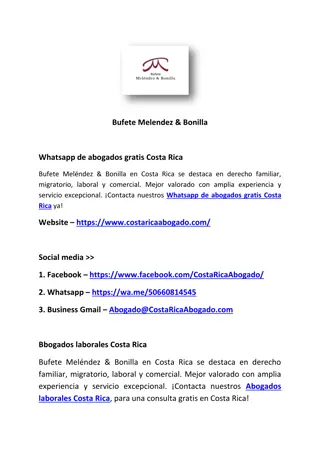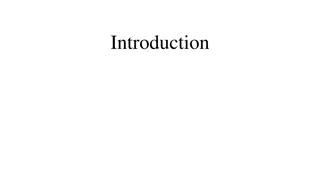
Walmart Financial Analysis: Cash, Receivables, Policies, Inventory
Explore Walmart's financial performance through its cash balance, accounts receivable, key accounting policies, allowance for doubtful accounts, and inventory trends over the past two years. Understand how Walmart manages its finances and accounting practices to maintain a competitive advantage and generate cash flow. Gain insights into the company's financial health and business strategies for sustainable growth.
Download Presentation

Please find below an Image/Link to download the presentation.
The content on the website is provided AS IS for your information and personal use only. It may not be sold, licensed, or shared on other websites without obtaining consent from the author. If you encounter any issues during the download, it is possible that the publisher has removed the file from their server.
You are allowed to download the files provided on this website for personal or commercial use, subject to the condition that they are used lawfully. All files are the property of their respective owners.
The content on the website is provided AS IS for your information and personal use only. It may not be sold, licensed, or shared on other websites without obtaining consent from the author.
E N D
Presentation Transcript
Week 2 Presentation Alexander Melendez ACC/42 Greg Watters January 27, 2020
Name of the company The name of the public company is: Walmart Inc. (WMT)
Notes relevant to Walmarts cash and cash equivalents Walmart generates lots of cash because it has a competitive advantage. In this regard, its yearly cash and cash equivalents declined from $6,867.00 Mil in 2017 to $6,756.00 Mil 2018, and then increased to $7,722.00 Mil in 2019. Notably, the company has ongoing businesses that generate more cash than it currently burns.
Notes relevant to accounts receivable Walmart s accounts receivable are only considered to be worth 75% its book value. In this case, for the quarter that ended in October 2019, it had net-net working capital worth $-122,935 Mil. The company measures its accounts receivable through the Days Sales Outstanding. For the last quarter October 2019, its Days Sales Outstanding was 4.00.
Walmarts key accounting policies Walmart calculates its inventories at lower of market or cost. For its segment inventories, it mostly uses first out and last in methods. Walmart prepares its annual account ting reports in conformity with GAAP. Notably, it uses different estimates in preparing these reports. It uses financial reporting and internal control to provide reasonable assurance in terms of financial reports.
The allowance for doubtful accounts Walmart makes some sales and failure to collect any payment. The conviction here is that the more the company collects cash as payment, the more the accounts receivable decrease. For financial report, the company uses straight line depreciation method.
Walmarts inventory for the last two years 2018: 43,783,000 2019 44,269,000
Walmart's policies for reporting inventory Walmart values inventories at the lower of either market of cost. Its inventory segments uses last-in, first-out as the inventory method of accounting. After valuation and LIFO, Walmart expects to either consume or sell the reserves of inventory within one year.
AR turnover and Days Outstanding for Receivable. 2018: 5,614,000 2019: 6,283,000 Average accounts receivables= (5,614,000 + 6,283,000)/2= 5,948,500 Credit sales: 514,405,000 AR turnover= 5,948,500/514,405,000= 0.012 Days outstanding for receivable: Accounts Receivable/Revenue*Days in Period. 0.012 * 91= 1 day.
Inventory turnover and Days Sales in Inventory. Average inventory: (43,783,000+44,269,000)/2= 44,026,000 Credit sales: 514,405,000 Inventory turnover= 44,026,000/514,405,000= 0.086 Days Sales in Inventory: Average inventory/revenue*91 0.086*91 Days Sales in Inventory= 8 days.






















